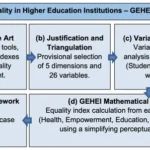Redefining Gender Equity: New Frontiers in Equality
Introduction
Gender equity is evolving, moving beyond traditional approaches to address modern challenges and opportunities. As society progresses, redefining gender equity involves exploring new frontiers and innovative strategies. This article delves into contemporary approaches to gender equity, emphasizing emerging trends and pioneering practices that aim to achieve true equality.

Understanding the Evolution of Gender Equity
Historical Context
Historically, gender equity focused on addressing basic inequalities and legal barriers. Early efforts were centered around:
- Legal Rights: Securing voting rights, workplace protections, and anti-discrimination laws.
- Visibility: Increasing the representation of women and marginalized genders in various sectors.
Modern Challenges
Modern gender equity faces new challenges, including:
- Intersectionality: Addressing the overlapping forms of discrimination faced by individuals based on race, class, and other factors.
- Economic Disparities: Tackling persistent wage gaps and economic inequalities that affect different genders.
New Frontiers in Gender Equity
Embracing Intersectionality
Intersectional Approach
An intersectional approach considers how different forms of discrimination intersect and affect individuals:
- Holistic Policies: Designing policies that address the complex realities of those facing multiple forms of discrimination.
- Inclusive Programs: Creating programs that cater to the diverse needs of intersecting identities.
Case Example: Multidimensional Support Systems
Programs offering multidimensional support, such as those providing services for LGBTQ+ individuals, women of color, and disabled persons, highlight the importance of intersectionality in addressing diverse needs.
Leveraging Technology and Data
Data-Driven Solutions
Technology and data analytics are transforming gender equity efforts:
- Predictive Analytics: Using predictive models to identify and address potential disparities before they become significant issues.
- Real-Time Monitoring: Implementing real-time data collection to track progress and quickly adapt strategies.
Case Example: Gender Equity Dashboards
Companies and organizations are adopting gender equity dashboards to visualize data related to gender representation, pay equity, and career progression, facilitating more informed decision-making.
Expanding Beyond Binary Gender Norms
Inclusive Policies
Policies are evolving to be more inclusive of non-binary and gender non-conforming individuals:
- Gender-Neutral Facilities: Providing gender-neutral restrooms and facilities to accommodate diverse gender identities.
- Flexible Definitions: Using inclusive language and definitions that reflect a spectrum of gender identities.
Case Example: Non-Binary Inclusion in Workplaces
Organizations implementing gender-neutral policies and practices, such as non-binary-inclusive health benefits and gender-neutral job applications, exemplify this shift toward inclusivity.
Promoting Economic Empowerment
Targeted Economic Initiatives
Economic empowerment initiatives are crucial for advancing gender equity:
- Financial Literacy Programs: Offering financial literacy and entrepreneurship programs tailored to women and marginalized genders.
- Support for Women-Owned Businesses: Providing grants, mentorship, and resources for women entrepreneurs.
Case Example: Women’s Entrepreneurship Programs
Programs like microfinance initiatives and business incubators focused on women entrepreneurs demonstrate a commitment to enhancing economic opportunities for women.
Redefining Gender Equity in Practice
Organizational Culture Shifts
Inclusive Leadership
Cultivating inclusive leadership is essential for driving gender equity:
- Diverse Leadership Teams: Building diverse leadership teams to ensure representation at decision-making levels.
- Inclusive Training: Providing training that emphasizes the importance of inclusivity and equitable practices.
Case Example: Diverse Leadership Programs
Organizations investing in leadership development programs for underrepresented groups are leading the way in creating equitable opportunities for career advancement.
Policy Innovations
Comprehensive Equity Policies
Innovative policies address broader aspects of gender equity:
- Parental Leave Reforms: Implementing policies that support all parents, including non-birthing parents, and provide equitable leave options.
- Pay Transparency: Adopting pay transparency measures to address and reduce wage gaps.
Case Example: Comprehensive Parental Leave Policies
Organizations with gender-neutral parental leave policies that support both parents in balancing work and family responsibilities are setting new standards for equity.
Measuring Impact and Sustaining Change
Continuous Assessment
Ongoing assessment is key to ensuring gender equity initiatives are effective:
- Impact Evaluations: Conducting evaluations to measure the impact of gender equity programs and policies.
- Feedback Mechanisms: Implementing feedback systems to gather insights from employees and stakeholders on equity efforts.
Adapting Strategies
Adapting strategies based on data and feedback is crucial:
- Flexible Approaches: Being open to adjusting strategies in response to new information and evolving needs.
- Continuous Improvement: Committing to continuous improvement and innovation in gender equity practices.
Conclusion
Redefining gender equity involves exploring new frontiers and embracing innovative approaches. By addressing intersectionality, leveraging technology, expanding beyond binary norms, and promoting economic empowerment, we can advance toward true equality. Implementing these forward-thinking strategies and continually assessing and adapting efforts will help create a more equitable and inclusive future.



